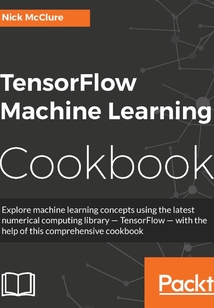舉報(bào) 

會(huì)員
TensorFlow Machine Learning Cookbook
最新章節(jié):
Index
Exploremachinelearningconceptsusingthelatestnumericalcomputinglibrary—TensorFlow—withthehelpofthiscomprehensivecookbookAboutThisBook?YourquickguidetoimplementingTensorFlowinyourday-to-daymachinelearningactivities?Learnadvancedtechniquesthatbringmoreaccuracyandspeedtomachinelearning?UpgradeyourknowledgetothesecondgenerationofmachinelearningwiththisguideonTensorFlowWhoThisBookIsForThisbookisidealfordatascientistswhoarefamiliarwithC++orPythonandperformmachinelearningactivitiesonaday-to-daybasis.Intermediateandadvancedmachinelearningimplementerswhoneedaquickguidetheycaneasilynavigatewillfindituseful.WhatYouWillLearn?BecomefamiliarwiththebasicsoftheTensorFlowmachinelearninglibrary?GettoknowLinearRegressiontechniqueswithTensorFlow?LearnSVMswithhands-onrecipes?Implementneuralnetworksandimprovepredictions?ApplyNLPandsentimentanalysistoyourdata?MasterCNNandRNNthroughpracticalrecipes?TakeTensorFlowintoproductionInDetailTensorFlowisanopensourcesoftwarelibraryforMachineIntelligence.TheindependentrecipesinthisbookwillteachyouhowtouseTensorFlowforcomplexdatacomputationsandwillletyoudigdeeperandgainmoreinsightsintoyourdatathaneverbefore.You’llworkthroughrecipesontrainingmodels,modelevaluation,sentimentanalysis,regressionanalysis,clusteringanalysis,artificialneuralnetworks,anddeeplearning–eachusingGoogle’smachinelearninglibraryTensorFlow.ThisguidestartswiththefundamentalsoftheTensorFlowlibrarywhichincludesvariables,matrices,andvariousdatasources.Movingahead,youwillgethands-onexperiencewithLinearRegressiontechniqueswithTensorFlow.Thenextchapterscoverimportanthigh-levelconceptssuchasneuralnetworks,CNN,RNN,andNLP.OnceyouarefamiliarandcomfortablewiththeTensorFlowecosystem,thelastchapterwillshowyouhowtotakeittoproduction.StyleandapproachThisbooktakesarecipe-basedapproachwhereeverytopicisexplicatedwiththehelpofareal-worldexample.
目錄(106章)
倒序
- coverpage
- TensorFlow Machine Learning Cookbook
- Credits
- About the Author
- About the Reviewer
- www.PacktPub.com
- eBooks discount offers and more
- Customer Feedback
- Preface
- What this book covers
- What you need for this book
- Who this book is for
- Sections
- Conventions
- Reader feedback
- Customer support
- Chapter 1. Getting Started with TensorFlow
- Introduction
- How TensorFlow Works
- Declaring Tensors
- Using Placeholders and Variables
- Working with Matrices
- Declaring Operations
- Implementing Activation Functions
- Working with Data Sources
- Additional Resources
- Chapter 2. The TensorFlow Way
- Introduction
- Operations in a Computational Graph
- Layering Nested Operations
- Working with Multiple Layers
- Implementing Loss Functions
- Implementing Back Propagation
- Working with Batch and Stochastic Training
- Combining Everything Together
- Evaluating Models
- Chapter 3. Linear Regression
- Introduction
- Using the Matrix Inverse Method
- Implementing a Decomposition Method
- Learning The TensorFlow Way of Linear Regression
- Understanding Loss Functions in Linear Regression
- Implementing Deming regression
- Implementing Lasso and Ridge Regression
- Implementing Elastic Net Regression
- Implementing Logistic Regression
- Chapter 4. Support Vector Machines
- Introduction
- Working with a Linear SVM
- Reduction to Linear Regression
- Working with Kernels in TensorFlow
- Implementing a Non-Linear SVM
- Implementing a Multi-Class SVM
- Chapter 5. Nearest Neighbor Methods
- Introduction
- Working with Nearest Neighbors
- Working with Text-Based Distances
- Computing with Mixed Distance Functions
- Using an Address Matching Example
- Using Nearest Neighbors for Image Recognition
- Chapter 6. Neural Networks
- Introduction
- Implementing Operational Gates
- Working with Gates and Activation Functions
- Implementing a One-Layer Neural Network
- Implementing Different Layers
- Using a Multilayer Neural Network
- Improving the Predictions of Linear Models
- Learning to Play Tic Tac Toe
- Chapter 7. Natural Language Processing
- Introduction
- Working with bag of words
- Implementing TF-IDF
- Working with Skip-gram Embeddings
- Working with CBOW Embeddings
- Making Predictions with Word2vec
- Using Doc2vec for Sentiment Analysis
- Chapter 8. Convolutional Neural Networks
- Introduction
- Implementing a Simpler CNN
- Implementing an Advanced CNN
- Retraining Existing CNNs models
- Applying Stylenet/Neural-Style
- Implementing DeepDream
- Chapter 9. Recurrent Neural Networks
- Introduction
- Implementing RNN for Spam Prediction
- Implementing an LSTM Model
- Stacking multiple LSTM Layers
- Creating Sequence-to-Sequence Models
- Training a Siamese Similarity Measure
- Chapter 10. Taking TensorFlow to Production
- Introduction
- Implementing unit tests
- Using Multiple Executors
- Parallelizing TensorFlow
- Taking TensorFlow to Production
- Productionalizing TensorFlow – An Example
- Chapter 11. More with TensorFlow
- Introduction
- Visualizing graphs in Tensorboard
- There's more…
- Working with a Genetic Algorithm
- Clustering Using K-Means
- Solving a System of ODEs
- Index 更新時(shí)間:2021-04-02 20:36:55
推薦閱讀
- 5G承載關(guān)鍵技術(shù)與規(guī)劃設(shè)計(jì)
- 真空鍍膜
- DSP原理及應(yīng)用:TMS320DM6437架構(gòu)、指令、功能模塊、程序設(shè)計(jì)及案例分析
- 鴻蒙原生應(yīng)用開(kāi)發(fā):ArkTS語(yǔ)言快速上手
- 彩色電視機(jī)檢測(cè)數(shù)據(jù)及信號(hào)波形實(shí)修實(shí)查大全
- 高速電路PCB設(shè)計(jì)與EMC技術(shù)分析
- 移動(dòng)寬帶技術(shù):LTE
- 微信小程序開(kāi)發(fā)與運(yùn)營(yíng)
- 液晶電視機(jī)檢修手冊(cè)
- 手繪圖說(shuō)萬(wàn)用表使用
- 手機(jī)故障維修技巧與實(shí)例
- 核心網(wǎng)架構(gòu)與關(guān)鍵技術(shù)
- 光伏發(fā)電系統(tǒng)智能化故障診斷技術(shù)
- 新型諾基亞手機(jī)維修技巧
- 基于FPGA密碼技術(shù)的設(shè)計(jì)與應(yīng)用
- UI 那些事兒:新手設(shè)計(jì)師的成長(zhǎng)之路
- 光纖通信技術(shù)
- 網(wǎng)絡(luò)多播和實(shí)時(shí)通信技術(shù)
- 基于Altera FPGA/CPLD的電子系統(tǒng)設(shè)計(jì)及工程實(shí)踐
- 通信電源(第3版)
- LTE系統(tǒng)原理及應(yīng)用
- 集成運(yùn)算放大器實(shí)用電路識(shí)圖
- 電子技術(shù)基礎(chǔ)仿真與實(shí)訓(xùn)
- LED照明驅(qū)動(dòng)器設(shè)計(jì)全實(shí)例詳解
- 模擬電子電路
- 6G無(wú)線傳輸技術(shù)
- 物聯(lián)網(wǎng)與短距離無(wú)線通信技術(shù)
- 電工電子實(shí)訓(xùn)
- MATLAB及在電子信息類(lèi)課程中的應(yīng)用(第2版)
- Flutter 開(kāi)發(fā)之旅從南到北

